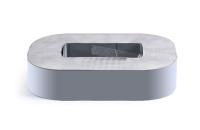
Seamless cores and traditional laminated cores are two common components in transformer manufacturing, each with its own characteristics and application scenarios. In the context of advancing electrical equipment, comparing their advantages and disadvantages helps in selecting the most suitable solution for specific needs.
First, seamless cores feature a continuous, integrated structure that eliminates the interlayer contact issues found in traditional laminated cores. This design significantly reduces eddy current losses, giving seamless cores superior electromagnetic performance. Especially under the demand for high efficiency and energy savings, seamless cores demonstrate lower no-load losses and greater magnetic performance stability.

Second, traditional laminated cores are composed of stacked layers of silicon steel sheets, offering a more mature and cost-effective manufacturing process. This makes them highly competitive in the mid-to-low-end market. Additionally, laminated cores provide greater flexibility in design, allowing adjustments to the shape and size of the layers to meet diverse application requirements. However, challenges such as localized hysteresis and eddy current losses caused by interlayer contacts remain significant limitations to performance improvements.
Third, seamless cores require high-precision molding and welding technology during manufacturing, resulting in higher production costs. This limits their widespread use in small and medium-sized transformers. However, in high-end markets such as ultra-high voltage systems and renewable energy applications, the performance advantages of seamless cores are fully realized, ensuring better system safety and reliability.
Furthermore, traditional laminated cores are more convenient for installation and maintenance. Their layered design allows for partial replacements in cases of damage or aging, reducing maintenance costs. In contrast, seamless cores, with their integrated structure, are harder to repair and often require complete replacement in case of failure.
In summary, seamless cores demonstrate stronger competitiveness in high-performance application scenarios, while traditional laminated cores dominate due to their cost advantages in more general applications. The choice between the two depends on a combination of factors, including performance requirements, budget constraints, and application contexts, to achieve optimal resource allocation and equipment efficiency.
Electrical steel production capacity is growing rapidly, and supply and demand are unbalanced
2023-12-05Dual-carbon drive, new energy and high energy efficiency give silicon steel new opportunities
2024-01-15What is silicon steel?
2022-09-14Why are bullets made of brass in all countries but stainless steel in China?
2021-10-20Demand analysis of non-oriented electrical steel at present stage
2023-11-23Three main surface treatment processes for stainless steel plates
2023-08-29






